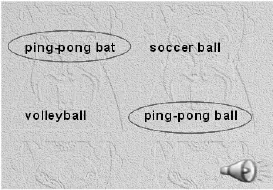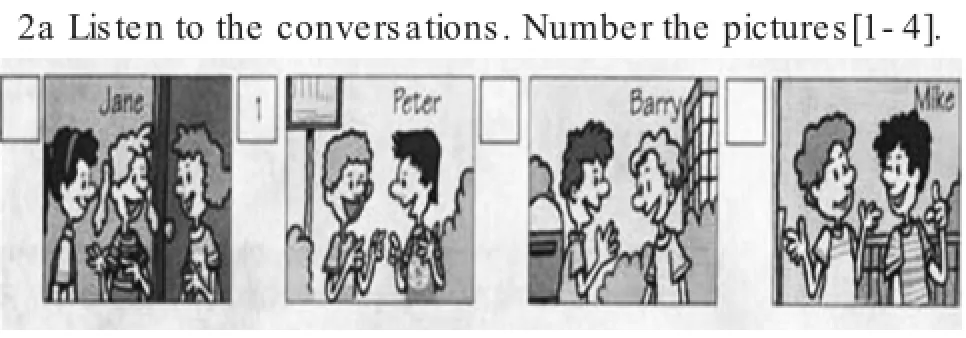“Unit 5 Do you have a soccer ball? Period 1(Section A 1a-2d)”教学设计及设计说明(二)
2015-12-02讷河市通南镇中心学校曲立明于小华
◎讷河市通南镇中心学校 曲立明 于小华
“Unit 5 Do you have a soccer ball? Period 1(Section A 1a-2d)”教学设计及设计说明(二)
◎讷河市通南镇中心学校 曲立明 于小华
〔此课选自人教版义务教育课程标准实验教科书《英语》(新目标2013版)七年级上册。〕
一、教学内容与分析
本单元的话题是运用一般现在时谈论物品所属关系,实现“描述物品是否属于某人”的语言功能,主要是学会用have对物品的所属进行提问以及应答,学会使用do和does引导的一般疑问句,使学生能够谈论自己喜欢哪些球类运动。通过多种学生活动的设计,把文字活化为语言,把教材活化为实际生活,把教学活化为交际。让学生自己动、自己学,在导学与活动中,突出个体与小组在活动中的主体意识,发挥主体性,真正成为活动课的主人。
二、教学目标
1.语言知识目标:
学习课文中的重点词汇have,ball,tennis,ping-pong,volleyball,basketball,let,us,late,get等,达到听、说、读、写四会;掌握并熟练运用一般现在时态的一般疑问句形式及其应答。
2.语言技能目标:
(1)对所属关系进行问答,如:Do you have a soccer ball?
(2)提出建议,发出邀请。如:Let’s playsoccer.
(3)谈论自己的感受。如:That sounds good.
3.情感态度:
通过各种活动,使学生在个体和小组活动中认识自己的学习目标和合作精神。
三、教学重、难点
重点:在活动过程中实现对重点词汇和短语的掌握,运用导学机制使学生熟练运用一般现在时态的行为动词have和助动词do和does的用法。
难点:如何在活动中引导学生自主实现重点知识的自学和运用。
四、教学方法
任务型教学法、活动教学法、导学法。
五、教学手段
实物、多媒体辅助教学、小组合作。
六、评价方法
综合形成性评价。
七、教学步骤
Step1:Activity 1
Showsome kinds ofballs tothe students.And ask:
T:What’s this in English?
S:It’s a volleyball.
T:What’s this in English?
S:It’s a basketball.
T:What’s this in English?
S:It’s a soccer ball.
T:Thisismysoccerball.Doyouhaveasoccerball?
(Help the students answer:Yes,I do./No,I don’t.)

Sum up:通过上面的活动,我们学到了有关球类的各种英文表达,他们是.
(设计说明:在课前的free talk中,给学生提供了语言交际的机会,通过让学生说出这些生活中常见的各种球类的英文名称,激发学生学习英语的兴趣,使学生自然地进入英语的学习氛围中,实现了平稳过渡。也使学生认识到了学习和学到的过程和结果的重要性。)
Step 2:Activity 2
(1)Make a list of the balls that students said just now on the blackboard.
For example:soccer,tennis,ping-pong,volleyball,basketball...
(2)Goon askingstudents:Doyou have a soccer ball?
Help students answer:Yes,I do./No,I don’t.
(设计说明:利用实物与球类活动相关的重点词汇和短语,熟练运用一般现在时态的一般疑问句形式对所属关系进行问答。)
(3)T:What’s this in English?
S1:It’s a basketball.
T:What color is it?
S2:It’s brown.
T:Whose basketball is it?
S3:It’s mine.
T:Let’s playit together.
S:That sounds great.
(Makingthe practice in pairs or groups.)
(设计说明:课前让学生带来自己的各种球,每种球选一两个拍照片,然后制作成课件展示。这时学生看到自己或是同学带来的球的图片被展示出来,会很兴奋地争着回答问题。)
Step 3:Activity 3
(1)Point tothe pictures(in the screen)in 1a and ask students what they see.At the same time,let them find out newwords and in pairs to learn them.(Chinese meaning and howtoread.)
(2)Ask students to match the words with the things in the picture.

(3)Givetheanswersingroups.(1.a 2.f 3.c 4.e 5.d 6.b)
(4)Practice the dialogue in desk mates.
A:Doyou have a ping-pongbat?
B:Yes,I do.
A:Doyou have a ping-pongball?
B:No,I don’t.
(5)Summingup in groups:通过上面的活动,我们知道了询问对方是否有某物时,应该表达为_________,这里的___是助动词,用来构成一般现在时的____。它的肯定答语是_____,否定答语是_____。
(Answers:Doyou have a/an...;do;疑问句;Yes,I do; No,I don’t.)
(设计说明:多媒体的使用加大了课堂容量,图片与日常活动的结合极大地调动了学生学习的积极性,学生积极讨论与参与,团结合作,气氛热烈。)
Step 4:Listening activity
(1)Point to the activities in the picture 1a.Ask students tolisten carefully.
(2)Students listen and circle the answers.
(3)Students check the answers each other.

(设计说明:有前面短语和句型的认知和练习做铺垫,听力任务显得较为轻松,教师可适当进行听力的指导。通过预习、练习、听力等系列活动,使学生重点知识得以掌握,难点得以突破。)
Step 5:Activity 4
(1)Show pictures to make the students make the dialogue one byone.

(2)Summingup in groups:通过上面的活动,我们知道了询问第三者(单数)是否有某物时,应该表达为_________,这里的______是助动词,用来构成一般现在时的________,后面要接动词的_______。它的肯定答语是_______,否定答语是________。
(Answers:Does she/he have a/an...;does;疑问句;原
形;Yes,he/she does;No,he/she doesn’t.)
(设计说明:学生在1a和1b的学习之后,利用本环节的问答练习进行所学知识的巩固和运用。采用one by one的活动形式可关照到每名学生,增强了教学效果。导学案的形式增加了课堂学习的目标性。)
Step 6:Listening activity
(1)Playthe recordingthe first time,students onlynumber the pictures.
(2)Students check the answers each other.(3,1,4,2)

(3)Play the recording the second time,students listen and match the pictures in 2a with the balls.
(4)Students check the answers each other.(3,2,1,4)

(设计说明:本环节是关于听说的重点学习环节,采用任务型方法进行设计,实现“听”的输入和“说”的输出,符合学生的认知规律。小组化的问答练习增加了学生活动的频率和能动性。)
Step 7:Activity 5
(1)Showtasks:
Look at the things in the picture.Ask your partner if he/she has the things in 2c.
(2)Askthestudentstoactouttheconversationinpairs.
1)S1:Doyou have a dictionary?S2:Yes,I do.
S1:Doyou have an eraser?S2:No,I don’t.
2)S3:Doyouhaveabaseball?S4:No,Idon’t.ButI haveabaseballbat.
S3:That sounds good.
3)S5:Does Tomhave volleyball?S6:Yes,he does.
S5:Does Mike have a pen?S6:No,he doesn’t.(3)Summingup in groups:通过上面的活动,我们主要学习了行为动词的_________,用来询问所属关系。表示“有”的两种形式是_______,其中have要借助助动词______来构成疑问,否定助动词是_______;has要借助助动词______来构成疑问句,否定助动词是_______。须要注意的是助动词后面用________。
(Answers:一般现在时;have/has;have/has;do;don’t; does;doesn’t;动词原形)

(设计说明:本活动在大量的对话练习基础上实现了交际功能,同时,让学生学会在小组合作的基础上自主探究,总结学习重难点,做到有“热闹”,有“认识”。)
Step 8:Activity 6
(1)Play the recording and students read the conversation after it together.
(2)Role-playthe conversation in pairs.
(设计说明:本环节重点在于对所学知识的运用上,以读为主,实现从听说的输入到实际情景的运用输出。)
(3)Let students use the information about their surveys topractice.

(设计说明:课前发给每个学生一张调查表(如上图),让学生利用图中的项目进行问答,从机械操练转入意义操练。学生可以在教室内自由走动,与自己的同伴用英语交流,培养学生对体育的热爱,提高学生的语言运用能力,让学生体会成功感。)
Step 9:Homework
Make up dialogues about“ownership and make suggestions”in pairs.You can do it by using words and phrases in the period.
(设计说明:本次作业的设置属于自主探究的活动
任务,并非单一的单词和短语的机械背诵和重复,考查学生对所学知识的运用程度。)
八、板书设计
Unit 5 Do you have a soccer ball?
Period 1(Section A 1a-2d)
have,ball,tennis,ping-pong,volleyball,basketball,let,us,late,get
Sentences:Doyou have a TV?Yes,I do./No.I don’t.
Dotheyhave a computer?Yes,theydo./No,theydon’t.
Does he/she have a soccer ball?Yes,he/she does./No,he/she doesn’t
Let’s playsoccer.I don’t have a soccer ball./That sounds good.
(设计说明:本节课的板书设计体现了词、短语和句型的核心内容,使其发挥突出重点、指导方法、预防错误的作用。)
